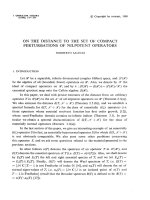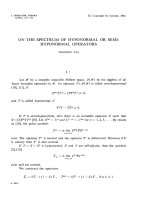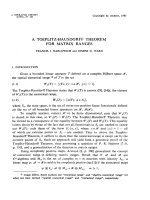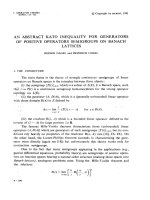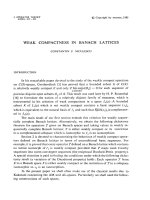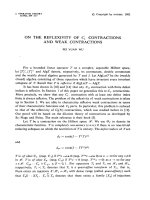Báo cáo toán học: "On the Smoothness of Solutions of the First Initial Boundary Value Problem for Schr¨dinger o Systems in Domains with Conical Points" pps
Bạn đang xem bản rút gọn của tài liệu. Xem và tải ngay bản đầy đủ của tài liệu tại đây (161.44 KB, 13 trang )
Vietnam Journal of Mathematics 33:2 ( 2005) 135–147
On the Smoothness of Solutions of the First
Initial Boundary Value Problem for Schr¨odinger
Systems in Domains with Conical Points
Nguyen Manh Hung and Cung The Anh
Department of Mathematics, Hanoi University of Education,
136 Xuan Thuy Road, Hanoi, Vietnam
Received March 12, 2004
Revised M arch 14, 2005
Abstract. Some results on the smoothness of generalized solutions of the first initial
b oundary value problem for strongly Schr¨odinger systems in domains with conical
p oints on boundary are given.
1. Introduction
Boundary value problems for Schr¨odinger equations and Schr¨odinger systems in
a finite cylinder Ω
T
=Ω× (0,T) have been studied by many authors [4,8,9].
The unique solvability of the first initial boundary value problem for strongly
Schr¨odinger systems in an infinite cylinder Ω
∞
=Ω×(0, ∞) was given in [5]. The
aim of this paper is to establish some theorems on the smoothness of generalized
solutions of the problem in domains with conical points on boundary.
Let Ω be a bounded domain in R
n
. Its boundary ∂Ω is assumed to be an
infinitely differentiable surface everywhere, except for the coordinate origin, in
a neighborhood of which Ω coincides with the cone K =
x : x/|x|∈G
,where
G is a smooth domain on the unit sphere S
n−1
. We introduce some notations:
Ω
T
=Ω× (0,T),S
T
= ∂Ω × (0,T), Ω
∞
=Ω× (0, ∞),S
∞
= ∂Ω × (0, ∞),x=
(x
1
, ,x
n
) ∈ Ω,u(x, t)=(u
1
(x, t), ,u
s
(x, t)) is a vector complex function,
|D
α
u|
2
=
s
i=1
|D
α
u
i
|
2
,u
t
j
=
∂
j
u
1
/∂t
j
, ,∂
j
u
s
/∂t
j
, |u
t
j
|
2
=
s
i=1
∂
j
u
i
/∂t
j
2
,
dx = dx
1
dx
n
,r= |x| =
x
2
1
+ ···+ x
2
n
.
In this paper we use frequently the following functional spaces:
136 Nguyen Manh Hung and Cung The Anh
• H
l
β
(Ω) - the space of all functions u(x)=(u
1
(x), ,u
s
(x)) which have gen-
eralized derivatives D
α
u
i
, |α|≤l,1≤ i ≤ s, satisfying
u
2
H
l
β
(Ω)
=
l
|α|=0
Ω
r
2(β+|α|−l)
|D
α
u|
2
dx < +∞.
• H
l,k
(e
−γt
, Ω
∞
) - the space of all functions u(x, t) which have generalized deriva-
tives D
α
u
i
,
∂
j
u
i
∂t
j
, |α|≤l,1≤ j ≤ k,1≤ i ≤ s, satisfying
u
2
H
l,k
(e
−γt
,Ω
∞
)
=
Ω
∞
l
|α|=0
|D
α
u|
2
+
k
j=1
|u
t
j
|
2
e
−2γt
dxdt < +∞.
In particular
u
2
H
l,0
(e
−γt
,Ω
∞
)
=
l
|α|=0
Ω
∞
|D
α
u|
2
e
−2γt
dxdt.
•
◦
H
l,k
(e
−γt
, Ω
∞
) - the closure in H
l,k
(e
−γt
, Ω
∞
) of the set of all infinitely dif-
ferentiable in Ω
∞
functions which belong to H
l,k
(e
−γt
, Ω
∞
) and vanish near
S
∞
.
• H
l,k
β
(e
−γt
, Ω
∞
) - the space of all functions u(x, t) which have generalized deriva-
tives D
α
u
i
,
∂
j
u
i
∂t
j
, |α|≤l,1≤ j ≤ k,1≤ i ≤ s, satisfying
u
2
H
l,k
β
(e
−γt
,Ω
∞
)
=
Ω
∞
l
|α|=0
r
2(β+|α|−l)
|D
α
u|
2
+
k
j=1
|u
t
j |
2
e
−2γt
dxdt < +∞.
• H
l
β
(e
−γt
, Ω
∞
) - the space of all functions u(x, t) which have generalized deriva-
tives D
α
(u
i
)
t
j
, |α| + j ≤ l,1≤ i ≤ s, satisfying
u
2
H
l
β
(e
−γt
,Ω
∞
)
=
l
|α|+j=0
Ω
∞
r
2(β+|α|+j−l)
|D
α
u
t
j
|
2
e
−2γt
dxdt < +∞.
• Let X be a Banach space. Denote by L
∞
(0, ∞; X) the space of all measurable
functions u :(0, ∞) −→ X
t −→ u(t)
, satisfying
u
L
∞
(0,∞;X)
= ess sup
t>0
u(t)
X
< +∞.
Consider the differential operator of order 2m
L(x, t, D)=
m
|p|,|q|=0
D
p
a
pq
(x, t)D
q
,
where a
pq
are s × s-matrices of measurable, bounded in Ω
∞
, complex functions,
a
pq
=(−1)
|p|+|q|
a
∗
qp
. Suppose that a
pq
are continuous in x ∈ Ω uniformly with
On the Smoothness of Solutions 137
respect to t ∈ [0, ∞)if|p| = |q| = m, and that for each t ∈ [0, ∞) the operator
L(x, t, D) is uniformly elliptic in
Ω with ellipticity constant a
0
independent of
time t, i.e., we have
|p|=|q|=m
a
pq
(x, t)ξ
p
ξ
q
ηη ≥ a
0
|ξ|
2m
|η|
2
, (1.1)
for all ξ ∈ R
n
\{0}, η ∈ C
s
\{0} and (x, t) ∈ Ω
∞
.
Put
B(u, u)(t)=
m
|p|,|q|=0
(−1)
|p|
Ω
a
pq
D
q
uD
p
udx, u(x, t) ∈
◦
H
m,0
(e
−γt
, Ω
∞
).
For a.e. t ∈ [0, ∞), the function x → u(x, t) belongs to
◦
H
m
(Ω). On the other
hand, since the principal coefficients a
pq
are continuous in x ∈ Ω uniformly
with respect to t ∈ [0, ∞) and the constant a
0
in (1.1) is independent of t,by
repeating the proof of Garding’s inequality [2, p.44], we have
Lemma 1.1. There exist two constants μ
0
and λ
0
(μ
0
> 0,λ
0
≥ 0) such that
(−1)
m
B(u, u)(t) ≥ μ
0
u(x, t)
2
H
m
(Ω)
− λ
0
u(x, t)
2
L
2
(Ω)
(1.2)
for all u(x, t) ∈
◦
H
m,0
(e
−γt
, Ω
∞
).
Therefore, using the transformation u = e
iλ
0
t
v if necessary, we can assume
that the operator L(x, t, D)satisfies
(−1)
m
B(u, u)(t) ≥ μ
0
u
2
H
m
(Ω)
(1.3)
for all u(x, t) ∈
◦
H
m,0
(e
−γt
, Ω
∞
). This inequality is a basic tool for proving the
existence and uniqueness of solutions of a boundary value problem.
2. Main Results
In this paper we consider the following problem: Find a function u(x, t)such
that
(−1)
m−1
iL(x, t, D)u − u
t
= f(x, t)inΩ
∞
, (2.1)
u|
t=0
=0, (2.2)
∂
j
u
∂ν
j
S
∞
=0,j=0, ,m− 1, (2.3)
where ν is the outer unit normal to S
∞
.
A function u(x, t) is called a generalized solution of the problem (2.1) - (2.3)
in the space
◦
H
m,0
(e
−γt
, Ω
∞
) if and only if u(x, t) belongs to
◦
H
m,0
(e
−γt
, Ω
∞
)
and for each T>0 the following equality holds
138 Nguyen Manh Hung and Cung The Anh
(−1)
m−1
i
m
|p|,|q|=0
(−1)
|p|
Ω
T
a
pq
D
q
uD
p
ηdxdt +
Ω
T
uη
t
dxdt =
Ω
T
fηdxdt
(2.4)
for all test function η ∈
◦
H
m,1
(Ω
T
) satisfying η(x, T )=0.
Denote by m
∗
the number of multi-indices which have order not exceeding
m, μ
0
is the constant in (1.3). From Theorems 3.1, 3.2 in [5] and by using
induction we obtain the following result.
Theorem 2.1. Let
i) sup
∂a
pq
∂t
:(x, t) ∈
Ω
∞
, 0 ≤|p|, |q|≤m
= μ<+∞;
∂
k
a
pq
∂t
k
≤ μ
1
,μ
1
= const > 0, for 2 ≤ k ≤ h +1;
ii) f
t
k ∈ L
∞
(0, ∞; L
2
(Ω)),fork ≤ h +1;
iii) f
t
k (x, 0) = 0, for k ≤ h.
Then for every γ>γ
0
=
m
∗
μ
2μ
0
, the problem (2.1) - (2.3) has exactly one
generalized solution u(x, t) in the space
◦
H
m,0
(e
−γt
, Ω
∞
). Moreover, u(x, t) has
derivatives with respect to t up to order h belonging to
◦
H
m,0
(e
−(2h+1)γt
, Ω
∞
)
and the following estimate holds
u
t
h
2
H
m,0
(e
−(2h+1)γt
,Ω
∞
)
≤ C
h+1
k=0
f
t
k
2
L
∞
(0,∞;L
2
(Ω))
,
where C is a positive constant independent of u and f .
From now on for the sake of brevity, we will write γ
h
instead of (2h+1)γ
(h =1, 2, , ).
In order to study the smoothness with respect to (x, t) of generalized solu-
tions of the problem (2.1) - (2.3), we assume that coefficients a
pq
(x, t)ofthe
operator L(x, t, D) are infinitely differentiable in
Ω
∞
. In addition, we also as-
sume that a
pq
and its all derivatives are bounded in Ω
∞
.
First, we prove the following lemma.
Lemma 2.1. Let f,f
t
,f
tt
∈ L
∞
(0, ∞; L
2
(K)) and f(x, 0) = f
t
(x, 0) = 0.If
u(x, t) ∈
◦
H
m,0
(e
−γt
, Ω
∞
) is a generalized solution of the problem (2.1) - (2.3) in
the space
◦
H
m,0
(e
−γt
, Ω
∞
) such that u ≡ 0 whenever |x| >R, R = const, then
u ∈ H
2m,1
m
(e
−γ
1
t
,K
∞
) and the following estimate holds
u
2
H
2m,1
m
(e
−γ
1
t
,K
∞
)
≤ C
f
2
L
∞
(0,∞;L
2
(K))
+f
t
2
L
∞
(0,∞;L
2
(K))
+f
tt
2
L
∞
(0,∞;L
2
(K))
,
where C = const.
Proof. Rewrite the system (2.1) in the following form
On the Smoothness of Solutions 139
(−1)
m
m
|p|,|q|=0
D
p
a
pq
(x, t)D
q
u
= F, (2.5)
where F = i(u
t
+ f). From Theorem 2.1 it follows that F ∈ L
2
(K) for a.e.
t ∈ [0, ∞).
Consider the sequence of domains
Ω
k
=
x ∈ K :2
−k
≤|x|≤2
−k+1
,k=1, 2,
Choosing a smooth domain Ω
2,0
such that Ω
2
⊂ Ω
2,0
⊂
Ω
1
∪ Ω
2
∪ Ω
3
. By the
theorem on the smoothness of solutions of elliptic problems in a smooth domain
[3, Th. 17.2, p. 67], we obtain
Ω
2,0
|D
α
u(x, t)|
2
dx ≤ C
Ω
2,0
F (x, t)
2
+
u(x, t)
2
dx, |α|≤2m, C =const.
Hence
Ω
2
|D
α
u(x, t)|
2
dx ≤ C
Ω
1
∪Ω
2
∪Ω
3
F (x, t)
2
+
u(x, t)
2
dx, |α|≤2m, C =const.
(2.6)
By substituting x =
4
2
k
1
x
(k
1
> 2) in (2.5) and applying the estimate (2.6), we
have
Ω
2
|D
α
x
u(x
,t)|
2
dx≤C
1
Ω
1
∪Ω
2
∪Ω
3
F (x
,t)
2
4
2
k
1
4m
+
u(x
,t)
2
dx
,C
1
=const.
Returning to variables x
1
, ,x
n
,weobtain
Ω
k
1
|D
α
u(x, t)|
2
r
2(|α|−m)
dx
≤ C
2
Ω
k
1
−1
∪Ω
k
1
∪Ω
k
1
+1
F (x, t)
2
r
2m
+r
–2m
u(x, t)
2
dx, C
2
=const.
Summing these inequalities for all k
1
> 2weobtain
k>2
Ω
k
D
α
u(x, t)
2
r
2(|α|−m)
dx
≤ C
3
k>1
Ω
k
F (x, t)
2
r
2m
+ r
−2m
u(x, t)
2
dx, C
3
=const.
(2.7)
140 Nguyen Manh Hung and Cung The Anh
Since the solution is equal to 0 outside a neighborhood of the conical point,
from (2.7) we have
K
D
α
u(x, t)
2
r
2(|α|−m)
dx ≤ C
4
K
F (x, t)
2
r
2m
+r
−2m
u(x, t)
2
dx, C
4
=const.
(2.8)
From conditions
∂
j
u
∂ν
j
S
∞
=0,j=0, ,m− 1, we have
K
r
−2m
u(x, t)
2
dx ≤ C
5
|β|=m
K
D
β
u
2
dx, C
5
=const.
Hence
K
r
2(|α|−m)
D
α
u(x, t)
2
dx
≤ C
6
K
|f|
2
+ |u
t
|
2
+
|β|=m
|D
β
u|
2
dx, C
6
=const,
Integrating this inequality with respect to t from 0 to ∞ after multiplying its
both sides by e
−6γt
and applying Theorem 2.1, we have the statement. Lemma
2.1 is proved.
Now let ω be a local coordinate system on S
n−1
. The principal part of the
operator L(x, t, D) at origin 0 can be written in the form
L
0
(0,t,D)=r
−2m
Q(ω, t, rD
r
,D
ω
),D
r
=
i∂
∂r
,
where Q is a linear operator with smooth coefficients. From now on the following
spectral problem will play an important role
Q(ω, t, λ,D
ω
)v(ω)=0,ω∈ G, (2.9)
D
j
ω
v(ω)=0,ω∈ ∂G, j =0, ,m− 1. (2.10)
It is well known [1, Th.7, p.39] that for every t ∈ [0, ∞) its spectrum is discrete.
Propostion 2.1. Let u(x, t) be a generalized solution of the problem (2.1) - (2.3)
in the space
◦
H
m,0
(e
−γt
, Ω
∞
) such that u ≡ 0 whenever |x| >R,R=const,and
let f
t
k ∈ L
∞
(0, ∞; L
2
(K)) for k ≤ 2m +1, f
t
k (x, 0) = 0 for k ≤ 2m. In addition
suppose that the strip
m −
n
2
≤ Im λ ≤ 2m −
n
2
does not contain points of spectrum of the problem (2.9) - (2.10) for every t ∈
[0, ∞).Thenu(x, t) ∈ H
2m
0
(e
−γ
2m
t
,K
∞
) and the following estimate holds
u
2
H
2m
0
(e
−γ
2m
t
,K
∞
)
≤ C
2m+1
k=0
f
t
k
2
L
∞
(0,∞;L
2
(K))
,
On the Smoothness of Solutions 141
where C =const> 0.
Proof. First, we prove that
u
t
s
2
H
2m,0
0
(e
−γ
s+1
t
,K
∞
)
≤ C
2m+1
k=0
f
t
k
2
L
∞
(0,∞;L
2
(K))
, (2.11)
where C =const,s ≤ 2m − 1.
Rewrite the system (2.1) in the form
(−1)
m
L
0
(0,t,D)u = F (x, t),
where F (x, t)=i(u
t
+ f)+(− 1)
m
L
0
(0,t,D) − L(x, t, D)
u.Sincea
pq
(x, t)
are infinitely differentiable in Ω
∞
and u(x, t) has generalized derivatives with
respect to x up to order 2m (see Lemma 2.1), we have
L(x, t, D)u =
2m
|α|=0
a
α
(x, t)D
α
u.
Since u ∈ H
2m,0
m
(e
−γ
1
t
,K
∞
)and|a
α
(x, t) − a
α
(0,t)|≤C|x|, C =const,onecan
see that
L
0
(0,t,D) − L(x, t, D)
u ∈ H
0,0
m−1
(e
−γ
1
t
,K
∞
).
(To verify this statement it suffices to consider the case r = |x|≤1). It follows
from Theorem 2.1 and Lemma 2.1 that F (x, t) ∈ H
0,0
m−1
(e
−γ
1
t
,K
∞
). Therefore
F ∈ H
0
m−1
(K) for a.e. t ∈ [0, ∞). On the other hand, in the strip m −
n
2
≤
Im λ ≤ m +1−
n
2
, there are no points of spectrum of the problem (2.9) - (2.10)
for every t ∈ [0, ∞). From results of elliptic problems [7, Th.6.4, p.139] it follows
that u ∈ H
2m
m−1
(K) for a. e. t ∈ [0, ∞)and
u
2
H
2m
m−1
(K)
≤ C
f
2
L
2
(K)
+ u
t
2
L
2
(K)
+ u
2
H
2m
m
(K)
,
where C =const. Repeating the above argument, we obtain
u
2
H
2m
0
(K)
≤ C
f
2
L
2
(K)
+ u
t
2
L
2
(K)
+ u
2
H
2m
m
(K)
.
Hence
u
2
H
2m,0
0
(e
−γ
1
t
,K
∞
)
≤ C
f
2
L
∞
(0,∞;L
2
(K))
+u
t
e
−γ
1
t
2
L
2
(K
∞
)
+u
2
H
2m,0
m
(e
−γ
1
t
,K
∞
)
.
From Theorem 2.1 and Lemma 2.1 it follows that
u
2
H
2m,0
0
(e
−γ
1
t
,K
∞
)
≤ C
2
k=0
f
t
k
2
L
∞
(0,∞;L
2
(K))
,
i.e., (2.11) is proved for s =0.
Now assume that (2.11) is true for s − 1. By differentiating the system (2.1)
s times with respect to t and by putting v = u
t
s
,weobtain
142 Nguyen Manh Hung and Cung The Anh
(−1)
m−1
Lv = −i(v
t
+ f
t
s
)+(−1)
m
s
k=1
s
k
L
t
k u
t
s−k ,
where
L
t
k =
m
|p|,|q|=0
D
p
∂
k
a
pq
∂t
k
D
q
.
By Theorem 2.1 the function v = u
t
s
still satisfies the boundary conditions.
Therefore from inductive hypothesis and by repeating arguments of the proof in
the case s = 0, we obtain (2.11).
Since
u
2
H
2m
0
(e
−γ
2m
t
,K
∞
)
≤
2m−1
s=0
u
t
s
2
H
2m,0
0
(e
−γ
s+1
t
,K
∞
)
+ u
t
2m
2
H
0,0
0
(e
−γ
2m
t
,K
∞
)
,
from (2.11) and Theorem 2.1, the statement follows. Proposition 2.1 is proved.
We consider now the following Dirichlet problem
⎧
⎨
⎩
(−1)
m
L
0
(0,t,D)u = F (x, t),x∈ K,
∂
j
u
∂ν
j
∂K
=0,j=0, ,m− 1.
(2.12)
Lemma 2.2. Let u(x, t) be a generalized solution of the Dirichlet problem
(2.12) for a.e t ∈ [0, ∞) such that u ≡ 0 whenever |x| >R, R =const, and
u(x, t) ∈ H
2m+l−1,0
β−1
(e
−γt
,K
∞
).LetF ∈ H
l,0
β
(e
−γt
,K
∞
).Thenu(x, t) ∈
H
2m+l,0
β
(e
−γt
,K
∞
) and
u
2
H
2m+l,0
β
(e
−γt
,K
∞
)
≤ C
F
2
H
l,0
β
(e
−γt
,K
∞
)
+ u
2
H
2m+l−1,0
β−1
(e
−γt
,K
∞
)
,
where C =const.
Proof. By repeating the proof of the inequality (2.6), we have
Ω
2
|D
μ
u(x, t)|
2
dx
≤ C
Ω
1
∪Ω
2
∪Ω
3
|α|≤l
|D
α
F (x, t)|
2
+ |u(x, t)|
2
dx, |μ| =2m + l,
where Ω
1
, Ω
2
, Ω
3
are defined as in Lemma 2.1, C = const. From this inequality
and by arguments which are analogous to the proof of the inequality (2.7), we
obtain
On the Smoothness of Solutions 143
K
r
2β
D
μ
u(x, t)
2
dx ≤ C
K
|α|≤l
r
2(β+|α|−l)
|D
α
F (x, t)|
2
+ r
2(β−2m−l)
|u(x, t)|
2
dx.
Integrating this inequality with respect to t from 0 to ∞ after multiplying its
both sides by e
−2γt
,wehave
K
∞
r
2β
D
α
u(x, t)
2
e
−2γt
dxdt
≤ C
F
2
H
l,0
β
(e
−γt
,K
∞
)
+
K
∞
r
2(β−2m−l)
|u(x, t)|
2
e
−2γt
dxdt
≤ C
F
2
H
l,0
β
(e
−γt
,K
∞
)
+ u
2
H
2m+l−1,0
β−1
(e
−γt
,K
∞
)
. (2.13)
We have
u
2
H
2m+l,0
β
(e
–γt
,K
∞
)
=
|μ|=2m+l
K
∞
r
2β
|D
μ
u(x, t)|
2
e
–2γt
dxdt+u
2
H
2m+l−1,0
β–1
(e
–γt
,K
∞
)
.
Hence and from (2.13) the statement follows. Lemma 2.2 is proved.
Proposition 2.2. Let f
t
k ∈ L
∞
(0, ∞; H
l
0
(K)) for k ≤ 2m + l +1,f
t
k (x, 0) = 0
for k ≤ 2m + l and let u(x, t) be a generalized solution of the problem (2.1) -
(2.3) in the space
◦
H
m,0
(e
−γt
, Ω
∞
) such that u ≡ 0 whenever |x| >R, R =const.
In addition suppose, that the strip
m −
n
2
≤ Im λ ≤ 2m + l −
n
2
does not contain points of spectrum of the problem (3.9) - (3.10) for every t ∈
[0, ∞).Thenu(x, t) ∈ H
2m+l
0
(e
−γ
2m+l
t
,K
∞
) and the following estimate holds
u
2
H
2m+l
0
(e
−γ
2m+l
t
,K
∞
)
≤ C
2m+l+1
k=0
f
t
k
2
L
∞
(0,∞;H
l
0
(K))
,
where C =const.
Proof. We will use induction on l.Ifl = 0, the statement follows from Proposi-
tion 2.1. Let the statement be true for l − 1.
We prove the inequality
u
2
H
2m+l−s
0
(e
−γ
2m+l−s
t
,K
∞
)
≤ C
2m+l+1
k=0
f
t
k
2
L
∞
(0,∞;H
l
0
(K))
, (2.14)
144 Nguyen Manh Hung and Cung The Anh
for s = l, l − 1, ,0, where C =const.
Since f
t
k ∈ L
∞
(0, ∞; H
l
0
(K)) for k ≤ 2m+l+1, f
t
k (x, 0) = 0 for k ≤ 2m +l,
so from Theorem 2.1 we obtain u
t
l+1 ∈ H
m,0
0
(e
−γ
l+1
t
,K
∞
). From this and from
arguments, which are analogous to the proof of Proposition 2.1, we obtain the
inequality (2.14) for s = l.
Assume that (2.14) is true for s = l, l − 1, ,j +1. Putv = u
t
j
.From
(2.11) it follows that
(−1)
m−1
Lv = F
j
,
where
F
j
= −i(v
t
+ f
t
j
)+(−1)
m
j
k=1
j
k
L
t
k u
t
j−k ,L
t
k =
m
|p|,|q|=0
D
p
∂
k
a
pq
∂t
k
D
q
.
By inductive hypothesis on l,weobtain
j
k=1
j
k
L
t
k u
t
j−k ∈ H
l−j
0
(e
−γ
l−j
t
,K
∞
).
On the other hand, by inductive hypothesis on s we have v
t
∈ H
l−j
0
(e
−γ
l−j
t
,K
∞
).
Therefore F
j
∈ H
l−j
0
(e
−γ
l−j
t
,K
∞
). Since
H
l−j
0
e
−γ
l−j
t
,K
∞
⊂ H
l−j−1,0
−1
(e
−γt
,K
∞
)
so F
j
∈ H
l−j−1,0
−1
(e
−γt
,K
∞
).
By repeating arguments which are analogous to the proof of Proposition 2.1,
we obtain v ∈ H
2m+l−j−1,0
−1
(e
−γt
,K
∞
). Hence and from Lemma 2.2 it follows
that u
t
j
= v ∈ H
2m+l−j,0
0
(e
−γt
,K
∞
)and
u
t
j
2
H
2m+l−j,0
0
(e
−γt
,K
∞
)
≤ C
2m+l+1
k=0
f
t
k
2
L
∞
(0,∞;H
l
0
(K))
, (2.15)
where C =const.
We have
u
t
j
2
H
2m+l−j
0
(e
−γ
2m+l−j
t
,K
∞
)
≤u
t
j+1
2
H
2m+l−j−1
0
(e
−γ
2m+l−j−1
t
,K
∞
)
+ u
t
j
2
H
2m+l−j,0
0
(e
−γt
,K
∞
)
. (2.16)
By inductive hypothesis on s, from (2.14) we obtain
u
t
j+1
2
H
2m+l−j−1
0
(e
−γ
2m+l−j−1
t
,K
∞
)
≤ C
2m+l+1
k=0
f
t
k
2
L
∞
(0,∞;H
l
0
(K))
,C=const.
Hence from this and (2.15), (2.16) it follows that
u
t
j
2
H
2m+l−j
0
(e
−γ
2m+l−j
t
,K
∞
)
≤ C
2m+l+1
k=0
f
t
k
2
L
∞
(0,∞;H
l
0
(K))
,C=const.
On the Smoothness of Solutions 145
For j = 0 we obtain the statement. Propostion 2.2 is proved.
We can now state our theorem on the smoothness of generalized solutions of
the problem (2.1) - (2.3) in the whole domain.
Theorem 2.2. Let u(x, t) be a generalized solution of the problem (2.1) - (2.3)
in the space
◦
H
m,0
(e
−γt
, Ω
∞
) and let f
t
k ∈ L
∞
(0, ∞; H
l
0
(Ω)) for k ≤ 2m + l +1,
f
t
k
(x, 0) = 0 for k ≤ 2m + l. In addition, supppose that the strip
m −
n
2
≤ Im λ ≤ 2m + l −
n
2
does not contain points of spectrum of the problem (2.9) - (2.10) for every t ∈
[0, ∞).Thenu(x, t) ∈ H
2m+l
0
(e
−γ
2m+l
t
, Ω
∞
) and the following estimate holds
u
2
H
2m+l
0
(e
−γ
2m+l
t
,Ω
∞
)
≤ C
2m+l+1
k=0
f
t
k
2
L
∞
(0,∞;H
l
0
(Ω))
,
where C =const.
Proof. Surrounding the point 0 by a neighborhood U
0
with small diameter so that
the intersection of Ω and U
0
coincides with K. Consider a function u
0
= ϕ
0
u,
where ϕ
0
∈
◦
C
∞
(U
0
)andϕ
0
≡ 1 in some neighborhood of 0. The function u
0
satisfies the system
(−1)
m−1
iL(x, t, D)u
0
− (u
0
)
t
= ϕ
0
f + L
(x, t, D)u,
where L
(x, t, D) is a linear differential operator having order less than 2m.The
coefficients of this operator depend on the choice of the function ϕ
0
and equal
to 0 outside U
0
. This and the arguments analogous to the proof of Proposition
2.2 show that
ϕ
0
u
2
H
2m+l
0
(e
−γ
2m+l
t
,Ω
∞
)
≤ C
2m+l+1
k=0
f
t
k
2
L
∞
(0,∞;H
l
0
(Ω))
. (2.17)
The function ϕ
1
u =(1−ϕ
0
)u equals 0 in some neighborhood of the conical point.
We can apply theorems on the smoothness of solutions of elliptic problems in a
smooth domain to this function and obtain ϕ
1
u ∈ H
2m+l
0
(Ω) for a.e. t ∈ [0, ∞).
Hence by Theorem 2.1 we have ϕ
1
u ∈ H
2m+l
0
(e
−γ
2m+l
t
, Ω
∞
)and
ϕ
1
u
2
H
2m+l
0
(e
−γ
2m+l
t
,Ω
∞
)
≤ C
2m+l+1
k=0
f
t
k
2
L
∞
(0,∞;H
l
0
(Ω))
. (2.18)
Since u = ϕ
0
u + ϕ
1
u so from (2.17) and (2.18) we obtain
u
2
H
2m+l
0
(e
−γ
2m+l
t
,Ω
∞
)
≤ C
2m+l+1
k=0
f
t
k
2
L
∞
(0,∞;H
l
0
(Ω))
.
Theorem 2.2 is proved.
Finally, we give an example.
146 Nguyen Manh Hung and Cung The Anh
Example. Consider the following problem
iu − u
t
= f in Ω
∞
, (2.19)
u|
t=0
=0, (2.20)
u|
S
∞
=0. (2.21)
The Laplacian in polar coordinate (r, ω)inR
n
is given by
(u)(r, ω)=
1
r
n−1
∂
∂r
r
n−1
∂
∂r
u(r, ω)+
1
r
2
ω
u(r, ω),
where
ω
is the Laplace - Beltrami operator on the unit sphere S
n−1
. It follows
that the spectral problem has the form
ω
v +[(iλ)
2
+ i(2 − n)λ]v =0,ω ∈ G, (2.22)
v|
∂G
=0. (2.23)
Let u(x, t) be a generalized solution of the problem (2.19) - (2.21) in the
space
◦
H
1,0
(e
−γt
, Ω
∞
). We consider the following cases:
1. Case n = 2. Assume that in a neighborhood of the coordinate origin, ∂Ω
coincides with a rectilinear angle having measure β. Then the problem (2.22) -
(2.23) becomes
v
ωω
− λ
2
v =0, 0 <ω<β,v(0) = v(β)=0. (2.24)
Upon some computations we find that eigenvalues of the problem (2.24) are
λ
k
= ±
ikπ
β
,k ∈ N
∗
. Therefore, if β<
π
l +1
then the strip 0 ≤ Imλ ≤ 1+l
does not contain eigenvalues of the problem (2.24). By Theorem 2.2, we obtain
that u(x, t) ∈ H
2+l
0
(e
−γ
2+l
t
, Ω
∞
)iff
t
k ∈ L
∞
(0, ∞; H
l
0
(Ω)) for k ≤ 2+l +1,
f
t
k
(x, 0) = 0 for k ≤ 2+l.
2. Case n = 3. It is known [6, p. 290] that if Ω is a convex domain, the strip
−
1
2
≤ Imλ<1 does not contain eigenvalues of the problem (2.22) - (2.23).
Thus, if Ω is convex, from Theorem 2.2 we have u(x, t) ∈ H
2
0
(e
−γ
2
t
, Ω
∞
)if
f,f
t
,f
tt
,f
ttt
∈ L
∞
(0, ∞; L
2
(Ω)), f (x, 0) = f
t
(x, 0) = f
tt
(x, 0) = 0.
3. Case n>3. In this case, the strip
1 −
n
2
≤ Imλ ≤ 2 −
n
2
does not contain eigenvalues of the problem (2.22) - (2.23) (see [6; p.289]). By
Theorem 2.2, we obtain that u ∈ H
2
0
(e
−γ
2
t
, Ω
∞
)iff,f
t
,f
tt
,f
ttt
∈ L
∞
(0, ∞; L
2
(Ω)),
f(x, 0) = f
t
(x, 0) = f
tt
(x, 0) = 0.
Acknowledgment. We would like to thank the referee for valuable comments.
On the Smoothness of Solutions 147
References
1. R. Dautray and J. L. Lions, Mathematical Analysis and Numerical Methods for
Science and Technology, Vol. 3, Springer - Verlag, 1990.
2. G. Fichera, Existence Theorems in Elasticity Theory, Mir, Moscow 1974 (in Rus-
sian).
3. A. Friedman, Partial Differential Equations, Holt - Rinehart - Winston, 1969.
4. N. M. Hung, The first initial boundary value problem for Schr¨odinger s ystems in
non-smooth domains,
Diff. Urav. 34 ( 1998) 1546–1556 (in Russian).
5. N. M. Hung and C. T. Anh, On the solvability of the first initial boundary value
problem for Schr¨odinger systems in infinite cylinders, Vietnam J. Math. 32
(2004) 41– 48.
6. V. A. Kondratiev, Boundary value problems for elliptic equations in domains
with conical or angular points, Trudy Mosk. Mat. Ob-va. 16 (1967) 209–292 ( in
Russian).
7. V. G. Mazya and B. A. Plamenevsky, Elliptic boundary value problems on mani-
folds with singularities, Problems Math. Anal. LGU, 1977, 85–145 (in Russian).
8. O. A. Ladyzhenskaya, On the non-stationary operator equations and its appli-
cation to linear p roblems of Mathematical Physics, Mat. Sbornik. 45 (1958)
123–158 ( in Russian).
9. O. A. Ladyzhenskaya, Boundary Value Problems of Mathematical Physics, Nauka,
Moscow , 1973 (in Russian).

